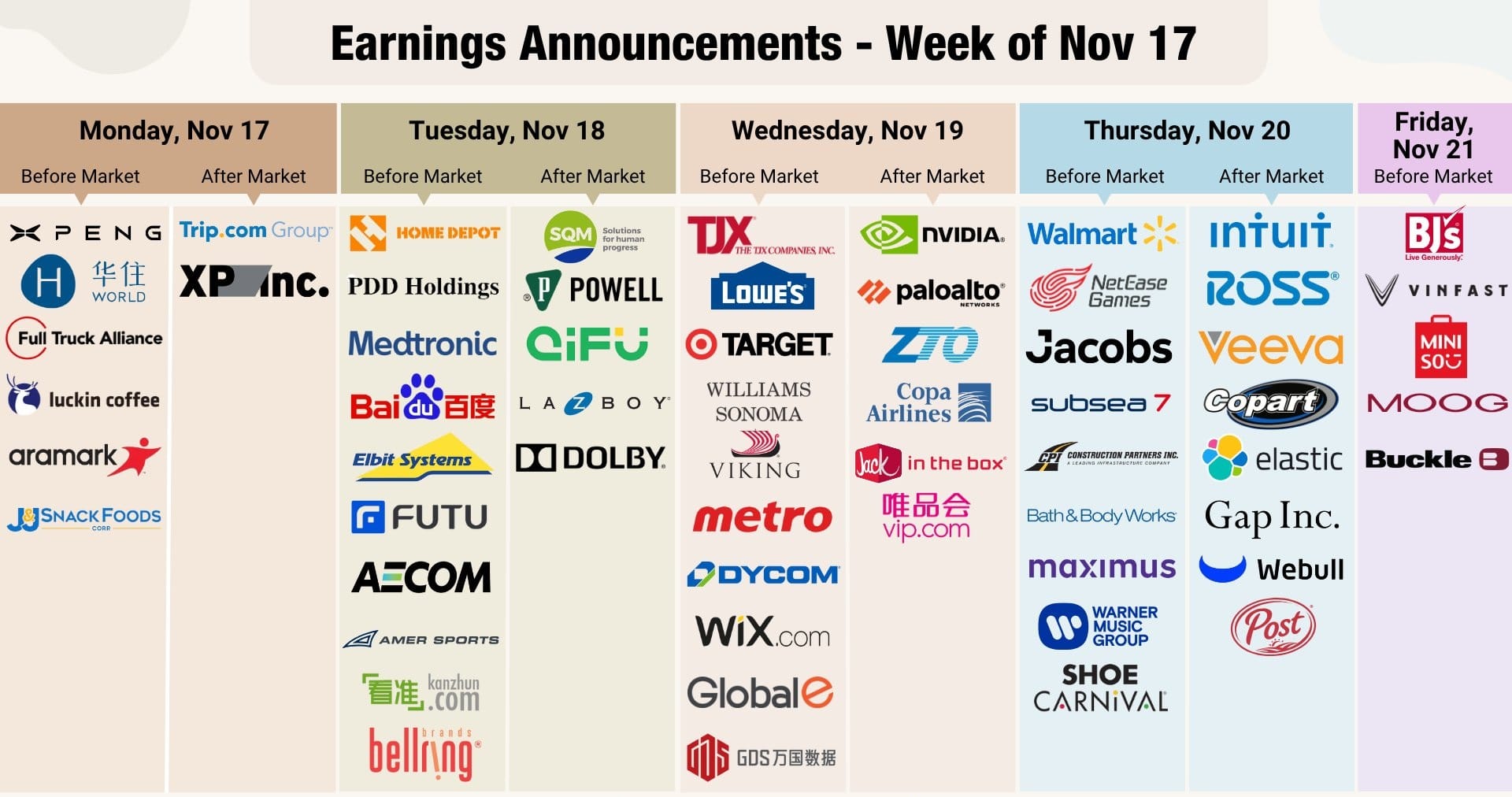North America News
US Stocks Close Higher, Russell 2000 Leads Gains
Major US equity indices ended Tuesday in positive territory, with small caps outperforming. The Russell 2000 gained 19.42 points (+0.83%), nearly double the advance of the NASDAQ Composite (+0.44%). The S&P 500 rose 0.41%, while the Dow Jones Industrial Average added 0.30%.
Sector performance (S&P 500):
- Industrials +1.04% (strongest)
- Financials +0.76%
- Health Care +0.55%
- Information Technology +0.53%
- Energy +0.42%
- Materials +0.41%
- Utilities +0.22%
- Consumer Discretionary -0.21%
- Telecom -0.27%
- Real Estate -0.33%
- Consumer Staples -0.46% (weakest)
Industrials and financials drove the day’s gains, while consumer staples and real estate services weighed on the broader index.
Treasury Sells $69B in 2-Year Notes at 3.641%
The US Treasury auctioned $69 billion in 2-year notes at a high yield of 3.641%, slightly below the WI level of 3.656% at the time of the auction.
- Bid-to-cover: 2.69x (vs. 2.59x average)
- Direct bidders: 33.16% (vs. 23% avg)
- Indirect bidders: 68.95% (vs. 66.1% avg)
- Dealers: 9.74% (vs. 10.9% avg)
The strong demand, reflected in the negative tail of -1.5 bps, underscored solid market appetite for short-term government debt.
Atlanta Fed GDPNow Tracker Eases
The Atlanta Fed’s GDPNow model now projects Q3 growth at 2.2%, slightly below the prior 2.3% estimate. The adjustment reflects modest revisions in consumer spending and investment data.
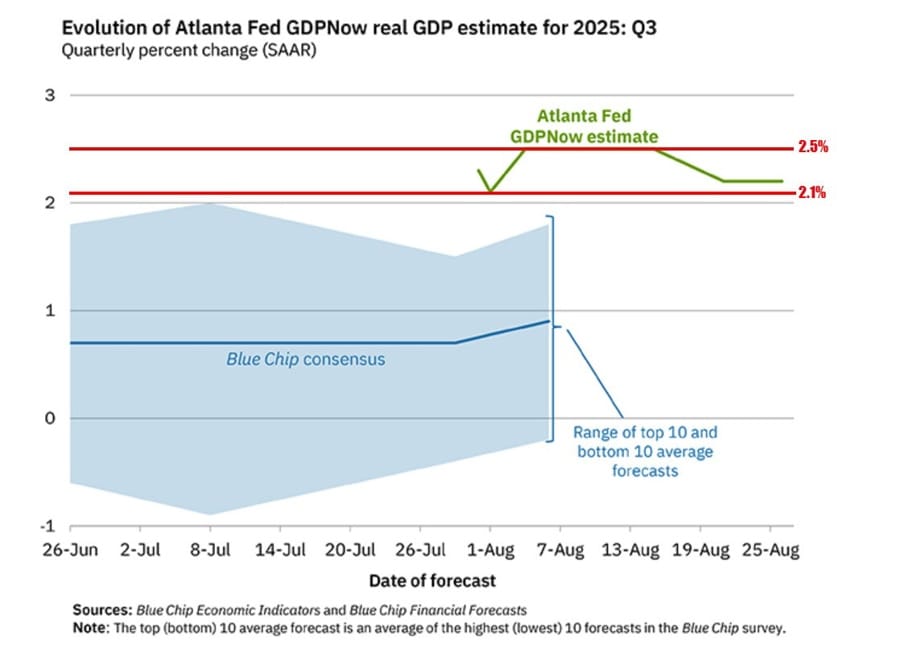
In their own words:
The GDPNow model estimate for real GDP growth (seasonally adjusted annual rate) in the third quarter of 2025 is 2.2 percent on August 26, down from 2.3 percent on August 19. After recent releases from the US Census Bureau and the National Association of Realtors, the nowcast of third-quarter real gross private domestic investment growth decreased from 4.9 percent to 4.4 percent.
US Consumer Confidence Holds Steady in August
The Conference Board’s Consumer Confidence Index registered 97.4 in August, slightly above expectations (96.2) but down from July’s revised 98.7.
- Current conditions:
- 22.0% say “good” (up from 20.5%).
- 14.2% say “bad” (up from 13.6%).
- Labor market views:
- 29.7% say jobs “plentiful” (down from 29.9%).
- 20.0% say jobs “hard to get” (up from 18.9%).
- Expectations (6 months):
- Business conditions: 19.5% better, 21.9% worse.
- Jobs: 17.9% more, 26.8% fewer.
- Income: 18.3% higher, 12.6% lower.
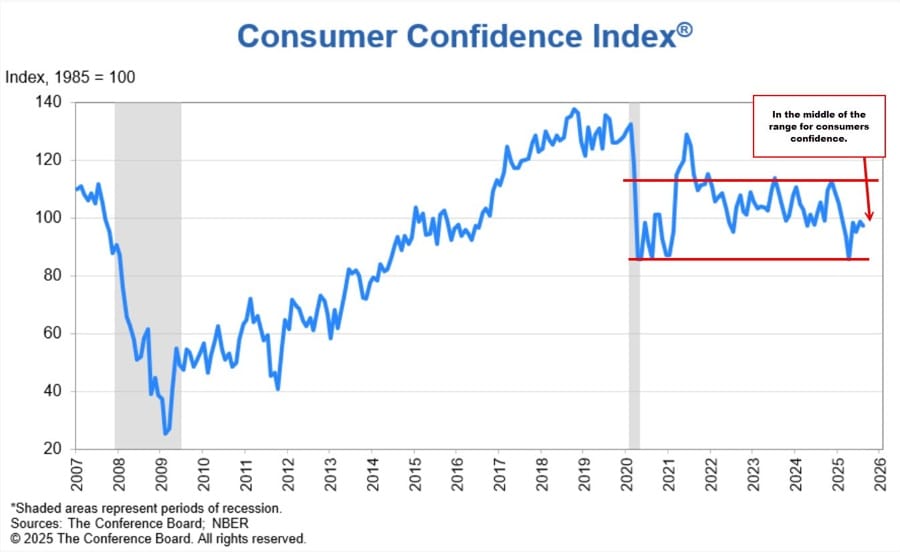
Sentiment remains resilient but cautious.
Stephanie Guichard, Senior Economist, Global Indicators at The Conference Board
“Consumer confidence dipped slightly in August but remained at a level similar to those of the past three months. The present situation and the expectation components both weakened. Notably, consumers’ appraisal of current job availability declined for the eighth consecutive month, but stronger views of current business conditions mitigated the retreat in the Present Situation Index. Meanwhile, pessimism about future job availability inched up and optimism about future income faded slightly. However, these were partly offset by stronger expectations for future business conditions.”
She added:
“Consumers’ write-in responses showed that references to tariffs increased somewhat and continued to be associated with concerns about higher prices. Meanwhile, references to high prices and inflation, including food and groceries, rose again in August. Consumers’ average 12-month inflation expectations picked up after three consecutive months of easing and reached 6.2% in August—up from 5.7% in July but still below the April peak of 7.0%.”
Richmond Fed Index Improves in August
The Richmond Fed composite index rose to -7 in August, better than the -11 estimate and up from -20 prior.
- Services index: +4 (vs. +2 prior).
- Shipments: -5 (vs. -18 prior).
- Employment and wages: both higher.
- Skills availability: fell.
- Prices paid: up sharply (7.24 vs. 5.65 prior).
- Prices received: steady (3.14).
Overall, conditions remain weak but are recovering from July’s deep contraction.
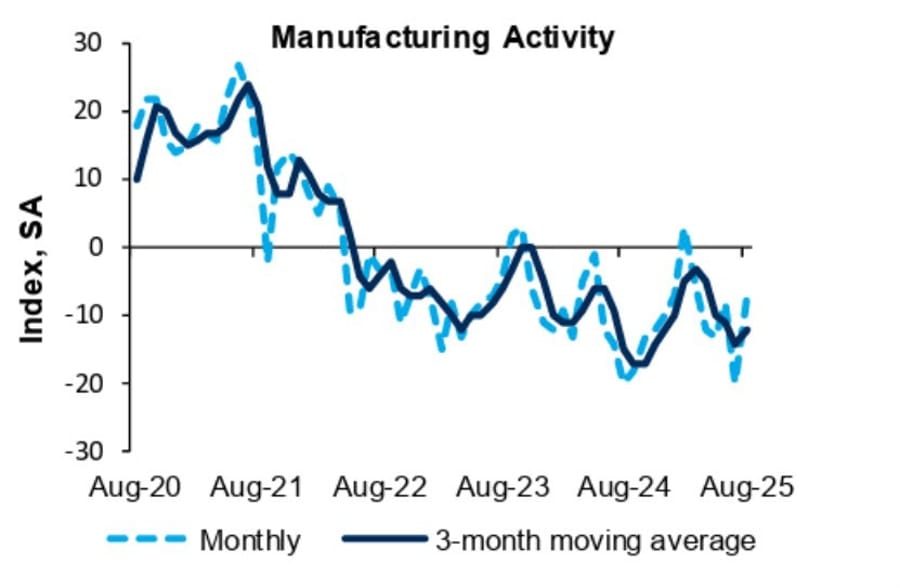
US Durable Goods Orders Fall Less Than Expected
US durable goods orders declined -2.8% in July, better than the -4.0% estimate, following June’s steep -9.4% drop.
- Ex-transportation: +1.1% (vs. +0.2% est.), prior revised to +0.3%.
- Ex-defense: -2.5% (vs. -3.6% est.), prior revised to -9.5%.
- Nondefense capital goods ex-air: +1.1% (vs. +0.2% est.), prior revised to -0.6%.
The headline decline signals weakness in transportation orders, but the rise in core capital goods suggests firms are still investing.
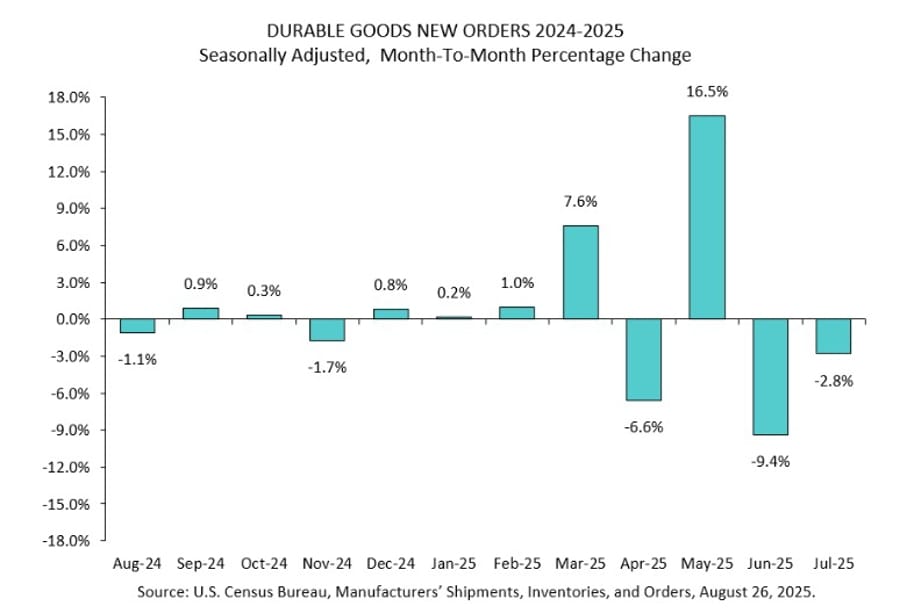
Case-Shiller: US Home Prices Slip Again in June
The Case-Shiller Home Price Index showed a -0.3% MoM decline in June, worse than the -0.2% estimate, matching May’s fall.
- YoY growth slowed to 2.1%, in line with expectations, down from 2.8% prior.
- Biggest YoY gainer: New York (+7.03%).
- Biggest YoY loser: Tampa (-2.38%).
MoM leaders: Chicago (+1.03%), Minneapolis (+0.67%), Detroit (+0.58%).
MoM laggards: San Francisco (-1.05%), Phoenix (-0.55%), Los Angeles (-0.43%).

Trump on Cook Dismissal: “We’re Ready for a Legal Fight”
President Trump said he is prepared to fight any legal challenge to his removal of Fed Governor Lisa Cook, describing it as stemming from “an infraction.”
He added that a replacement is ready, noting “we do have to get rates down a little bit.” Trump said it is “fortunate” that Fed Chair Jerome Powell will soon be gone, predicting his administration will soon hold a majority on the board.
Fed on Cook Removal: “For Cause” Protection Applies
The Federal Reserve released a statement on the dismissal of Governor Lisa Cook, emphasizing that under the Federal Reserve Act, board members serve fixed terms and may only be removed by the president “for cause.”
The Fed stressed that these protections are essential to ensure policy decisions remain based on data and long-term stability rather than politics. Cook, through her attorney, confirmed she will challenge the decision in court. The Fed said it will comply with any court ruling while continuing to carry out its mandate.
US to Back European Air Defense Shield for Ukraine
The US is set to provide security guarantees for Ukraine, according to the Financial Times.
- Will contribute air defense assets, intelligence, surveillance, and reconnaissance.
- Support will complement a European-led air defense shield.
- Part of broader post-war security framework to integrate Ukraine into Western defense networks.
Fed’s Barkin: US Workforce Growth Zero Without Immigration
Richmond Fed President Thomas Barkin warned that US labor force growth is “basically zero without immigration.”
- Without new workers, GDP expansion depends almost entirely on productivity gains.
- Productivity-driven growth requires innovation and efficiency gains to offset stagnant labor supply.
- A shrinking worker base could strain fiscal balances, with fewer workers supporting more retirees.
- While tight supply may boost wages, Barkin stressed the broader risk of slower, more fragile long-term growth.
Former Fed Governor Brainard: Trump moves risk higher inflation, long-term rates
- Comments from the former Fed Governor, Lael Brainard
- This is an unprecedented attack on the Fed.
- The Fed is likely to cut by 25 bps at September meeting.
Credit Agricole Joins Consensus: Two Fed Cuts by Year-End
Credit Agricole has shifted its outlook in line with other major banks, forecasting two Federal Reserve rate cuts in 2025. The bank expects reductions in September and December, but unlike its peers, it projects a higher terminal rate at around 4.00%.
The firm argues that while the U.S. economy is slowing, it is not in recession. Inflation, though easing, remains sticky—particularly as tariff pass-through effects could temporarily drive prices higher. That, Credit Agricole believes, limits how aggressively the Fed can ease.
The bank also highlighted that the labor market, despite recent signs of cooling, remains relatively resilient. That provides the Fed with leeway to slow the pace of easing, balancing inflation risks with growth concerns.
Morgan Stanley Now Forecasts Two Fed Rate Cuts in 2025
Morgan Stanley has reversed its earlier outlook and now expects the Federal Reserve to lower rates twice before the year ends. Previously, the bank anticipated no cuts in 2025.
The firm now sees one reduction coming in September, followed by another in December. Beyond that, Morgan Stanley envisions a steady easing cycle in 2026, with the Fed cutting rates once per quarter until reaching a terminal target range of 2.75% to 3.00%.
This latest revision follows a string of dovish signals from Fed Chair Powell, whose comments at Jackson Hole reinforced expectations that policy is shifting toward accommodation. With inflation cooling and risks to employment climbing, major Wall Street institutions are increasingly aligned in calling for Fed action sooner rather than later.
Fed Governor Cook Rejects Trump’s Firing Attempt
Fed Governor Lisa Cook pushed back against Trump’s claim to have removed her, stating she will not resign and that no legal basis exists for her dismissal.
Cook emphasized she will continue performing her duties, arguing the president lacks authority to fire a Fed governor except “for cause.” While she faces unresolved mortgage fraud allegations, no ruling has been made.
The unprecedented clash underscores threats to Fed independence. Even if Cook remains legally in place, Trump’s attempt could hinder her effectiveness inside the central bank.
Trump Threatens Tariffs Over Digital Taxes
Trump warned on his social media platform that countries maintaining digital taxes or measures seen as discriminatory toward U.S. tech firms could face steep new tariffs. He also threatened export restrictions on semiconductors, signaling an aggressive stance against policies he views as harmful to American companies.

Trump Ousts Fed Governor Cook, Markets React Sharply
President Trump announced the immediate removal of Federal Reserve Governor Lisa Cook via his social media platform, escalating his attacks on Fed independence.
The move sent the U.S. dollar lower, while gold prices jumped as investors sought safe havens. Trump has repeatedly pressed the Fed to cut rates and is expected to nominate a replacement more aligned with his policy stance.
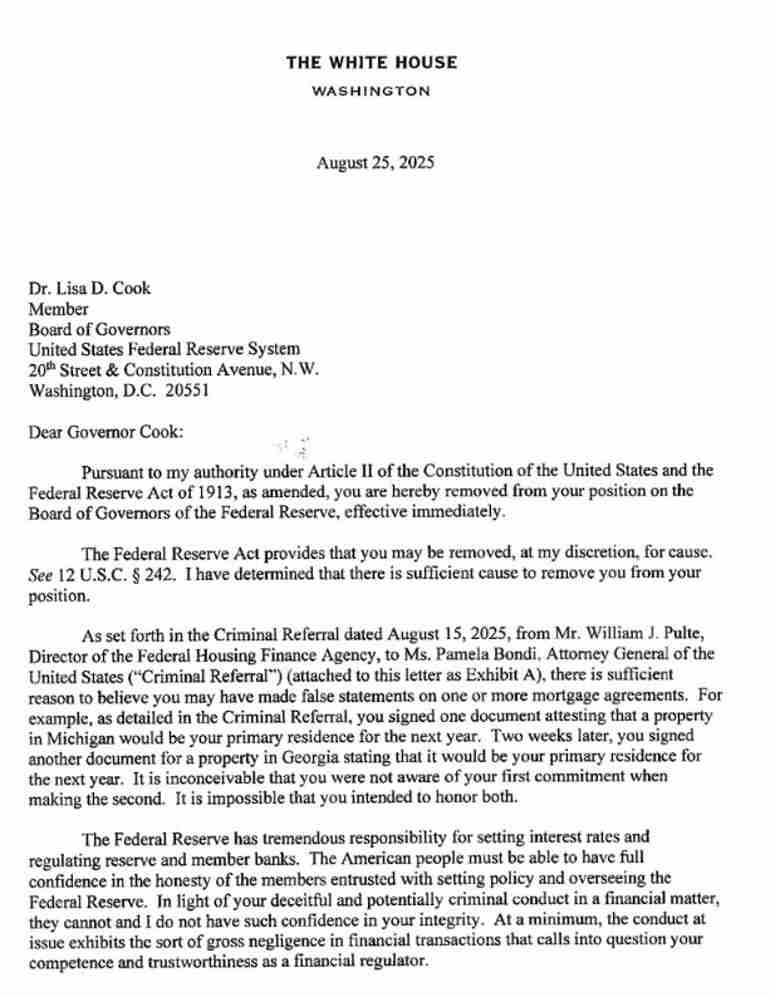
U.S. Finalizes $50B Boeing and GE Aerospace Deal with Korean Air
Washington has secured a major $50 billion order from Korean Air, covering 100 Boeing aircraft and GE Aerospace engines. The announcement coincides with President Lee Jae Myung’s state visit to Washington.
The deal underscores deepening U.S.–Korea trade ties and comes after months of negotiations between the two governments.
UBS Sees Fed Cuts Starting in September, Bullish on Equities
UBS Wealth Management expects the Federal Reserve to begin cutting rates at the September FOMC meeting, projecting four quarter-point reductions through January 2026.
The bank said easing will likely proceed unless labor markets remain unexpectedly strong or inflation stages a rebound. With U.S. rates poised to move lower and Europe already near the bottom of its cycle, UBS sees global equities trending higher over the next 6–12 months, supported by corporate investment and Fed policy.
Barclays Predicts Two Fed Cuts in 2025, Warns of 50% Recession Risk Under Trump
Barclays has shifted its U.S. outlook, forecasting two Federal Reserve rate cuts in 2025—in September and December—after Powell’s Jackson Hole comments leaned toward easing. The bank also projects additional cuts in 2026, bringing rates to 3.25%–3.50% by late that year.
The firm warns the risk of a U.S. recession under a Trump administration is now 50%. They expect jobs growth to slow, unemployment to climb to 4.2%, and further Fed cuts to follow as the economy weakens.
Still, Barclays notes that September easing is not guaranteed. A stronger-than-expected August jobs report could keep policymakers from acting.
Dallas Fed’s Lorie Logan Offers No Hint of September Rate Move
Speaking at the Bank of Mexico Centennial Conference, Dallas Federal Reserve President Lorie Logan avoided giving any indication on whether the Fed might cut interest rates in September.
Logan argued that policymakers should avoid putting too much weight on the “median” projection when assessing Fed policy, stressing that a range of perspectives across the committee is just as important. She also suggested there is still room to refine how the Fed communicates around its balance sheet.
On the Fed funds rate, Logan said the central bank should continue reviewing whether it is best practice to communicate the target in a range rather than a single figure.
BoC Macklem: Inflation Target Stays at 2%
Bank of Canada Governor Tiff Macklem confirmed the central bank will not revisit its 2% inflation target during next year’s policy framework review.
Macklem warned that steep new US tariffs and unpredictable US trade policy have reduced efficiency and raised uncertainty, complicating monetary policy. He said supply headwinds could push inflation higher but reaffirmed the 2% target remains in place.
Commodities News
Gold Holds Near $3,400 as Fed Uncertainty Weighs on Dollar
Gold prices steadied just below $3,400/oz on Tuesday as a weaker US dollar and political drama surrounding the Federal Reserve supported safe-haven demand. The fallout from President Trump’s move to dismiss Fed Governor Lisa Cook has raised fresh doubts about the central bank’s independence.
Falling Treasury yields at the short and intermediate maturities also helped underpin bullion, while markets continue to price in potential Fed rate cuts as early as September after Chair Powell’s dovish Jackson Hole remarks. Softer US data added to the supportive backdrop: July durable goods orders fell 2.8%, and the Conference Board’s consumer confidence index weakened in August.
Key levels to watch:
- Resistance: $3,409 (Aug 8 high), $3,439 (Jul 23 peak), $3,451 (Jun 16 top)
- Support: $3,268 (Jul 30 low), $3,247 (Jun 30 low), $3,120 (May 15 low), 200-day SMA at $3,062
Oil Settles Lower at $63.25, Trump Eyes $60
US crude oil futures settled at $63.25, down $1.55 (-2.39%) on the day. The decline came after President Trump said he expects oil to trade below $60 soon, calling lower crude prices a policy priority.
Trump also noted domestic production is up by 300,000 barrels per day. Technically, crude tested the 200-hour moving average at $63.15 after breaking below its 100-hour moving average at $63.62, raising the risk of a further drop toward the recent low at $61.45.
Trump Expects Oil Below $60, Rejects Renewables
At a cabinet meeting, Donald Trump said oil prices are likely to “break $60 soon” as domestic production rises by 300,000 bpd.
He reiterated opposition to renewables:
- Solar: “takes up acres away from farming.”
- Wind: “no windmills either.”

Oil Prices Push Higher Amid Fading Peace Prospects in Ukraine
Crude oil prices extended gains into the new week, supported by both falling U.S. inventories and renewed geopolitical risks. Brent climbed to $69 per barrel, while WTI reached $65.
According to Commerzbank analyst Carsten Fritsch, hopes for a peace deal in Ukraine—once seen as plausible after tentative diplomatic moves—are evaporating. Statements from Moscow suggest talks between Presidents Putin and Zelensky are unlikely anytime soon. With sanctions relief off the table, risks to Russian exports remain acute.
Compounding the pressure, Ukraine has escalated attacks on Russian energy infrastructure. Drone strikes last week targeted the Druzhba pipeline, disrupting flows to Hungary and Slovakia, and hit a refinery in southern Russia. Over the weekend, another attack struck a major export port near St. Petersburg.
These strikes have already forced down Russia’s seaborne exports to their lowest in six months, according to Bloomberg data. While exports through Baltic ports have held steady, volumes from the Pacific coast have slipped.
Fritsch warns that Kazakhstan’s exports could also be vulnerable, given their reliance on Russian infrastructure. Combined, these risks suggest Russian supply to global markets is likely to shrink further, justifying the recent rise in prices.
Gold Outlook Turns to Labor Market After Powell’s Dovish Tilt
Gold prices surged following Fed Chair Jerome Powell’s dovish remarks at Jackson Hole, but the spotlight now shifts to U.S. labor market data due next week. Traders see the Non-Farm Payrolls report as a crucial determinant of whether the Fed moves to cut rates in September.
Fundamental backdrop: Powell’s acknowledgment that risks to employment are growing, and that policy may already be overly restrictive, pushed investors toward gold and firmed up bets on two cuts before year-end. However, strong jobs data could quickly challenge that narrative, pulling back expectations for easing and capping gold’s upside.
Technical setup:
- Daily chart: Gold is holding in the middle of its current range, boxed in by resistance at $3,438 and support at $3,245. Until a breakout occurs, traders are likely to play this range.
- 4-hour chart: Friday’s rally gave way to a pullback into the $3,350 swing level, where buyers re-entered the market. This zone remains pivotal—another retest could attract dip-buyers, while a breakdown could open the door toward $3,245 support.
- 1-hour chart: Intraday resistance has formed around $3,379. Bulls need to clear this barrier to build momentum toward $3,438, while bears will see it as a chance to sell with stops above the level.
Overall, gold’s longer-term trend remains bullish on expectations of falling real yields, but short-term volatility will hinge on jobs data.
Gold Surges on Powell Speech but Faces Resistance at $3,400
Gold prices jumped by nearly $50 to just under $3,380 per ounce on Friday, following dovish remarks from Fed Chair Powell. Speaking at the Jackson Hole Symposium, Powell emphasized that tariff-driven inflation was temporary and pointed to risks for employment, laying the groundwork for a potential September rate cut.
The speech prompted a sharp repricing in Fed Funds futures, with traders now almost fully pricing in a September move. The dollar weakened, bond yields declined, and gold surged as investors sought protection against easier policy.
Commerzbank analyst Carsten Fritsch noted that while the rally was significant, gold’s momentum may stall short of the $3,400 threshold. The price in euros rose as well, though less dramatically, suggesting the move was largely dollar-driven.
For gold to push higher, markets may need a fresh catalyst—potentially political, such as Trump’s attempt to fire Fed Governor Cook, which could undermine the Fed’s independence and further boost safe-haven demand.
European Gas Prices Rise on Geopolitical and Supply Concerns
European natural gas prices climbed last week, with front-month TTF futures rising more than 8%, as optimism for a Russia-Ukraine peace deal waned and supply risks in Norway emerged.
ING analysts Ewa Manthey and Warren Patterson said market sentiment turned bullish after it became clear that maintenance work in Norway could tighten flows, while political risks in Eastern Europe persist.
EU gas storage is currently 76% full—comfortably higher than the five-year average of 83% but well below last year’s 91%. Meanwhile, U.S. gas has moved in the opposite direction, with Henry Hub down 7.5% for the week. Despite a smaller-than-expected build in inventories, overall U.S. storage remains nearly 6% above its five-year average.
As summer demand eases, analysts expect further builds heading into the winter season, but in Europe, geopolitical uncertainty continues to exert upward pressure.
Oil Market Braces for U.S. Secondary Tariffs on India
Oil prices closed nearly 3% higher last week, lifted by fading hopes of a Russia-Ukraine ceasefire and ongoing uncertainty around U.S. sanctions. President Trump warned that unless a peace deal is struck within two weeks, Washington may impose harsher penalties on Moscow.
Adding to the market’s jitters, secondary tariffs on Indian refiners buying Russian oil are set to take effect on August 27. According to ING analysts Manthey and Patterson, Indian refiners have shown increased interest in Russian barrels despite the looming 25% levy. That suggests the tariffs may not significantly alter trade flows, but they could reinforce bearish sentiment for oil prices.
Speculators have already pared their positions. Net long positions in ICE Brent fell by nearly 24,000 lots last week, leaving the smallest long exposure in WTI since 2008.
For now, oil traders are watching Powell’s dovish tilt at Jackson Hole, which boosted risk assets broadly, but the market remains vulnerable to geopolitical and trade developments.
Europe News
European Stocks End Lower; US Markets Flat
European equities fell sharply Tuesday, with broad-based declines as investors rotated out of risk.
- France CAC: -1.70% (worst performer).
- Italy FTSE MIB: -1.32%.
- Germany DAX: -0.50%.
- UK FTSE 100: -0.60%.
- Spain Ibex: -0.96%.
US stocks were little changed.

French Consumer Confidence Hits Lowest Since October 2023
Household sentiment in France weakened further in August, according to data released by the national statistics office INSEE. The consumer confidence index dropped to 87, undershooting expectations of 89 and marking the lowest reading since October 2023. July’s figure was also revised lower, from 89 to 88.
The deterioration reflects persistent pessimism over jobs and living standards. Unemployment expectations remain elevated, and households’ outlook on their future standard of living fell sharply, with the sub-index declining two more points to -64—its weakest since March 2023.
The reading underscores the fragility of consumer morale at a time when growth in the eurozone’s second-largest economy is already under pressure.
UK Shop Prices Rise at Fastest Pace Since March 2024
The British Retail Consortium reported that U.K. shop prices jumped 0.9% in August, the sharpest monthly increase since March 2024. Food inflation was the key driver, with prices up 4.2%—the steepest rise since February 2024. Items such as butter, eggs, and chocolate saw notable increases due to high demand, labor costs, and weak harvests.
The Bank of England has warned that rising food inflation could keep broader inflation expectations elevated and push wage demands higher. U.K. CPI hit 3.8% in July, an 18-month high, and is forecast to reach 4% in September before cooling.
Data:
- BRC Shop Price Index (Y/Y) August 2025: +0.9% (expected +1.0%, prior +0.7%)
BOE Mann: Research is showing increased persistence in inflation, but weak growth outlook
- Mixed stagflation signals from inflation and growth as per MPC member Mann
- Research shows increased persistence in inflation but also points to a weak growth outlook.
- Combination of two shocks makes the monetary policymaker’s job harder.
- In my view, upside risks to inflation through inflation persistence are playing out.
- Downside risk to demand scenario remains a risk but is not my central case.
- Inflation persistence scenario implies a significantly tighter path for policy than is embedded in the market curve, not explicitly my view.
- A more persistent hold on Bank Rate is appropriate right now to maintain the tight monetary policy stance needed to lean against inflation persistence.
- I stand ready for a forceful policy action, in the form of larger, more rapid Bank Rate cuts, should the downside risks to domestic demand start materializing.
French Government at Risk as Bayrou Ties Budget to Confidence Vote
Markets reacted sharply after French Prime Minister François Bayrou announced he would tie his €44 billion budget-cutting plan to a September 8 confidence vote. France’s minority government could collapse, with opposition parties—the far-right National Rally, Greens, and Socialists—already set against him.
Bond markets showed stress, with French spreads over German Bunds widening to their highest levels since June, while the CAC 40 fell 1.6%.
If Bayrou loses, his cabinet will be forced out, leaving President Emmanuel Macron to either appoint a new premier, keep Bayrou on in a caretaker role, or dissolve parliament for fresh elections. France’s debt burden, at 5.8% of GDP in 2024—nearly double EU limits—was cited by Bayrou as reason for the risky gambl
Asia-Pacific & World News
Senior Chinese Trade Envoy Heads to Washington for Talks
China’s top trade negotiator Li Chenggang will travel to Washington this week for the first round of formal discussions under the current tariff truce. He will meet U.S. Trade Representative Jamieson Greer, Treasury officials, and American business leaders.
The talks aim to establish a regular dialogue to reduce trade friction. Both sides have agreed to suspend new tariffs until early November, with discussions expected to cover Chinese rare earth exports and U.S. technology goods.
Global Parcel Trade Disrupted as U.S. Ends $800 Tariff Exemption
The expiration of the U.S. “de minimis” tariff exemption, which had allowed goods worth $800 or less to enter tariff-free, is disrupting small parcel trade worldwide. Postal operators across Europe and Asia—including Royal Mail, Deutsche Post, Bpost, France’s La Poste, Japan Post, and Australia Post—have halted or restricted shipments to the U.S.
The change follows Trump’s earlier revocation of the exemption for Chinese parcels, now extended globally as of August 29. Carriers say unclear U.S. Customs rules and insufficient implementation time left them unable to comply.
The move affects hundreds of millions of annual shipments, from personal gifts to e-commerce purchases. In 2024 alone, 1.3 billion parcels entered under the exemption, with roughly 60% originating from China. Discount retailers like Shein and Temu face significant cost increases as their low-price model relied heavily on duty-free entry.
PBOC sets USD/ CNY reference rate for today at 7.1188 (vs. estimate at 7.1670)
- PBOC CNY reference rate setting for the trading session ahead.
PBOC injected 405.8bn yuan via 7-day reverse repos at 1.40%
- 580.3bn yuan mature today
- net 174.5bn yuan drain

RBA Minutes Signal More Rate Cuts Ahead
Minutes from the Reserve Bank of Australia’s August 11–12 meeting revealed policymakers see room for further easing over the coming year. The RBA cut its cash rate by 25 basis points at the meeting but noted policy is still restrictive.
The board highlighted uncertainty around spare capacity, the neutral rate, and global risks. While some members favored a gradual pace of cuts, others argued for faster moves if labor market slack emerges sooner than expected.
Officials also discussed house prices, which were rising but remained within historical norms, and noted risks from U.S. tariff policy, though the worst-case outcomes had been avoided. The RBA will continue allowing its government bond portfolio to run off passively.
Japan Trade Negotiator Refuses to Confirm $550 Billion U.S. Investment Deal
Japan’s lead trade negotiator, Ryosei Akazawa, has sidestepped questions about a supposed $550 billion U.S.-bound investment package, telling reporters he had “no comment” when pressed on remarks made by financier Howard Lutnick earlier this week.
Lutnick claimed that an agreement would be announced shortly, describing it as a $550 billion investment “at the hand of Donald Trump.” Japanese officials, however, have not confirmed any such figure, and Akazawa’s silence adds to doubts over whether the package exists in the form suggested.
Akazawa instead emphasized Japan’s immediate goal: securing a presidential order to cut U.S. tariffs on Japanese goods. The U.S. has imposed 15% tariffs under the new framework agreement, while Tokyo is reportedly offering a mix of government-backed loans and guarantees in exchange. Yet details remain scarce, and the Japanese government has not provided clarity on how any such commitments would be structured.
Akazawa is expected to travel to Washington soon to formalize elements of the trade deal. For now, though, skepticism remains high as Japanese officials continue to withhold confirmation of the investment package.
Japan’s Finance Minister Kato Warns on FX Volatility
Finance Minister Shunichi Kato voiced concern over sharp movements in the yen, saying speculative flows are distorting currency markets. While declining to comment on specific levels, Kato stressed the need for stable exchange rates that reflect fundamentals.
He also addressed other issues, saying Japan’s ruling parties will debate how to replace revenue from the gasoline surcharge tax, while JGB markets and interest rates remain under close watch.
Japan’s Services PPI Eases to 2.9% in July
Japan’s Corporate Services Price Index (CSPI), often called services PPI, rose 2.9% year-on-year in July, below both the 3.2% consensus forecast and the prior month’s 3.2% increase.
On a monthly basis, the index gained 0.3%, rebounding from June’s 0.2% decline. The softer reading suggests a slight easing of inflationary pressure in the services sector.
Crypto Market Pulse
Crypto Market: Bitcoin, Ethereum Pull Back Despite ETF Inflows
Bitcoin (BTC) dipped to $108,666 in overnight trading before rebounding above $110,000, but market sentiment remains weak. Ethereum (ETH) and XRP also struggled despite growing demand for crypto ETFs.
- Ethereum ETFs: Posted $443.91M in net inflows Monday, with cumulative inflows at $12.87B and net assets near $28.84B. Traders are rotating from BTC to ETH, with one whale reportedly selling nearly 24,000 BTC to buy ETH.
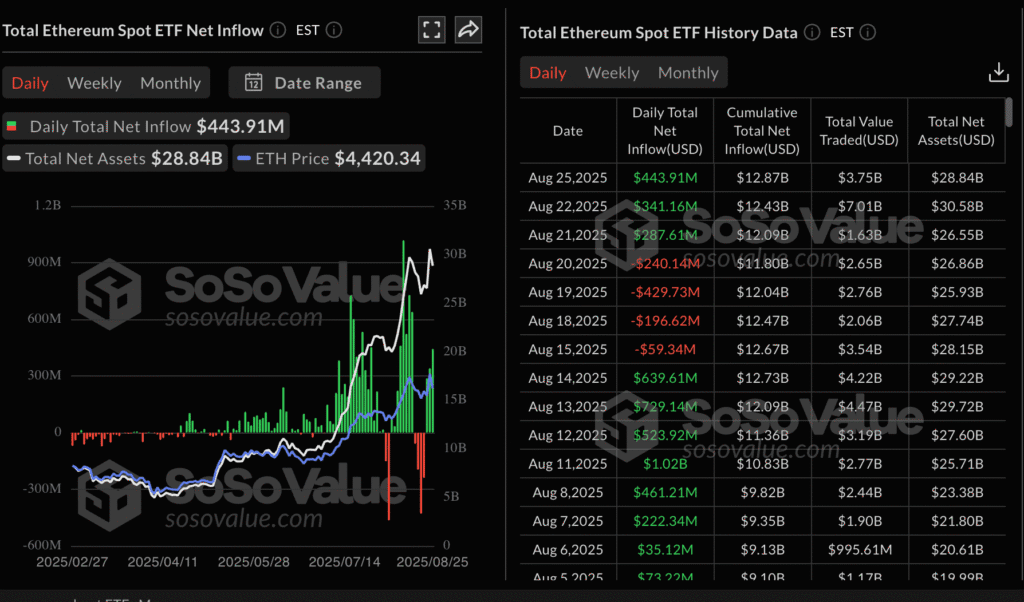
- Bitcoin ETFs: Resumed inflows with $219M Monday, bringing cumulative totals to $54B.
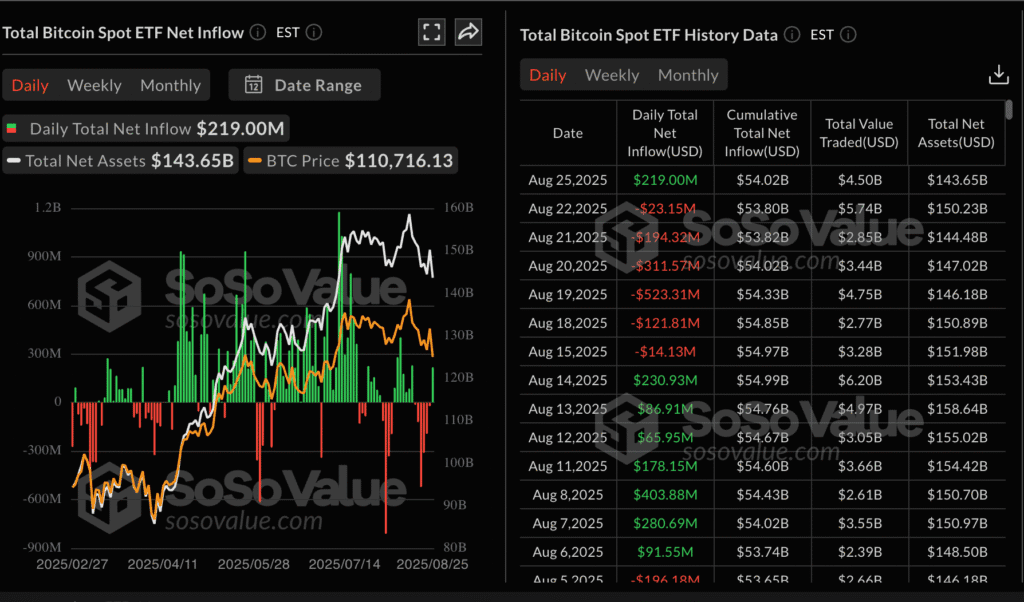
- Ethereum price: Trades above $4,400, still supported by the 50-day EMA at $3,881. The next bullish target is the prior high near $4,955.
- XRP: Struggles below $3.00 and the 50-day EMA at $2.94, with rising liquidations ($16M longs vs. $1.8M shorts). The 100-day EMA at $2.75 offers key support.
Analysts warn the broader risk-off sentiment is capping upside momentum, but stabilizing ETF flows could reignite a push higher in September.
Chainlink Rises as Bitwise Files for LINK ETF
Chainlink (LINK) rebounded above $23 after asset manager Bitwise filed for a spot LINK ETF with the SEC.
- Custody: Coinbase Custody Trust Company.
- Trading: ETF would list on a US exchange (venue TBD).
- Filing includes creation/redemption process with in-kind and cash options.
- Despite recent weak derivatives activity (open interest fell to $1.6B from $1.8B), optimism is growing for a potential breakout above $30.

Trump Media, Crypto.com Launch $6.4B CRO Strategy
Trump Media & Technology Group, owner of Truth Social, announced a $6.42B digital asset strategy with Crypto.com and Yorkville Acquisition.
- Focus: building the largest publicly traded CRO treasury.
- Initial funding: $1B in CRO tokens + $420M in cash/warrants + $5B credit line.
- Majority-owned by Trump Media, with 1-year lockup + 3-year staggered release.
The venture aims to be the largest digital asset treasury company by market cap ratio in history.
BONK Faces Pressure Despite Modest Bounce
Bonk (BONK), the Solana-based meme token, continues to struggle under a bearish technical setup, despite a modest 2% rebound on Tuesday. The coin slipped below the $0.000020 threshold, extending its decline from a July peak near $0.000040.

Multiple technical indicators are weighing on sentiment. BONK remains stuck beneath its 50-day, 100-day, and 200-day moving averages, while open interest in derivatives has plunged. CoinGlass data shows OI at just $28 million, down sharply from $73 million in July.

Funding rates are also subdued at 0.0018%, suggesting limited appetite for leveraged long positions. Without stronger conviction from traders, upward moves may remain short-lived, and BONK risks further downside.

Solana Slips Under $200 as Liquidation Risks Mount
Solana (SOL) tumbled 9% on Monday, sliding under $200 and raising concerns that bears are eyeing a deeper correction. The selloff coincided with net outflows of $167.8 million, the third-largest this year, as traders pulled tokens amid collapsing spot prices.

CoinGlass data suggests the market could see up to $176 million in long liquidations if SOL drops below $185, highlighting the fragility of current positioning. Conversely, a recovery above $190 could trigger $102 million in short liquidations.
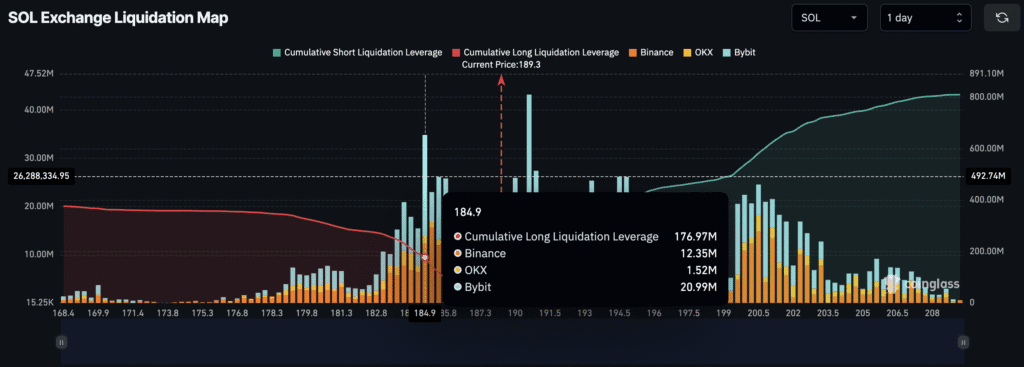
At press time Tuesday, SOL was staging a small 0.5% rebound, but the risk of cascading liquidations continues to hang over the market.
Hyperliquid Surges as TVL and Fees Break Records
Hyperliquid (HYPE) advanced more than 4% on Tuesday, trading above $44 after rebounding from key support. The token’s momentum is being fueled by surging network activity, with Artemis Terminal data showing that Hyperliquid’s 24-hour chain fees of $2.6 million surpassed those of both Ethereum and Tron.
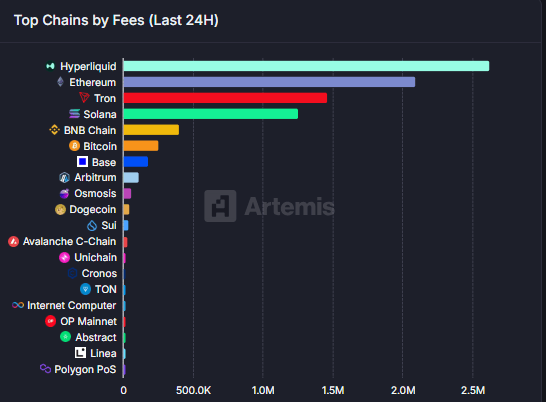
Total Value Locked (TVL) in the Hyperliquid ecosystem has also climbed to a record $2.3 billion, underscoring growing adoption. Traders are taking notice: Coinglass’s long-to-short ratio for HYPE has reached 1.20, the highest in over a month, indicating a tilt toward bullish positioning.

With both network fees and TVL hitting new milestones, sentiment around HYPE is strengthening, even as broader crypto markets remain mixed.
Bitcoin Slides Below $110K as Heavy Selling Resurfaces
Bitcoin faced another sharp sell-off late Sunday in U.S. trading hours after around 24,000 BTC was unloaded in a single move, sending the price under $110,000. The scale and timing suggested a deliberate push to drive the market lower.
Although there was a partial retracement, the downward momentum appears to be holding. This marks a fresh low in the latest downturn.
The move comes alongside renewed flows into the U.S. dollar following last week’s comments from Powell. Still, the magnitude of the Bitcoin decline points to factors beyond simple dollar strength.

The Day’s Takeaway
North America
- Equities: Major US indices closed higher Tuesday, led by small caps. The Russell 2000 gained 0.83%, nearly twice the NASDAQ’s 0.44% advance. The S&P 500 rose 0.41%, while the Dow Jones added 0.30%. Industrials (+1.04%) and financials (+0.76%) led S&P sector gains, while consumer staples (-0.46%) and real estate (-0.33%) lagged.
- Durable Goods: July orders fell -2.8%, better than the expected -4.0%. Ex-transportation rose 1.1% and nondefense capital goods ex-air also climbed 1.1%, suggesting continued business investment.
- Housing: The Case-Shiller index showed a second straight -0.3% MoM decline in June, with YoY growth slowing to 2.1% from 2.8%. New York led gains (+7.03% YoY), while Tampa posted the sharpest loss (-2.38%).
- Fed Speak: Richmond Fed President Barkin warned US workforce growth is “basically zero without immigration,” highlighting risks to long-term GDP.
- Regional Activity: The Richmond Fed index improved to -7 in August (from -20), signaling conditions remain weak but are recovering.
- Consumer Sentiment: The Conference Board index slipped to 97.4 from 98.7 but topped forecasts (96.2). Views on the labor market softened, though consumers remain cautiously resilient.
- GDP Tracker: Atlanta Fed’s GDPNow estimate eased to 2.2% from 2.3% for Q3.
- Treasury Auction: The US sold $69B in 2-year notes at 3.641%, with strong demand (bid-to-cover 2.69x).
- Policy & Politics: The Fed stressed Governor Lisa Cook is protected by “for cause” removal provisions under the Fed Act, setting up a legal fight with the White House. President Trump said he is “ready for a legal fight” and confirmed a replacement is prepared.
Canada: BoC Governor Macklem reaffirmed the 2% inflation target will remain unchanged. He warned US tariffs and trade unpredictability are undermining efficiency and complicating policy.
Commodities
- Gold: Held just below $3,400/oz, supported by a softer USD, lower yields, and Fed uncertainty. Key resistance stands at $3,409 (Aug 8 high), with support at $3,268 (Jul 30 low).
- Oil: WTI crude settled at $63.25 (-2.39%) after Trump predicted prices would fall below $60 soon, citing rising US production (+300,000 bpd). Technically, crude broke below its 100-hour moving average, opening risk for a move toward $61.45.
Europe
- Equities: European stocks slid sharply. CAC -1.70% led declines, followed by FTSE MIB -1.32%, Ibex -0.96%, FTSE 100 -0.60%, and DAX -0.50%. Investors rotated out of risk.
- Geopolitics: The US confirmed support for a European-led air defense shield for Ukraine, pledging assets and intelligence as part of a long-term security framework.
Crypto
- Bitcoin & Ethereum: BTC dipped to $108,666 overnight before rebounding above $110K. ETH remains firm above $4,400, supported by ETF inflows. Ethereum ETFs saw $444M net inflows Monday, with cumulative inflows of $12.9B. BTC ETFs also resumed inflows ($219M), bringing totals to $54B. XRP struggled below $3.00 with heavy liquidations.
- Chainlink (LINK): Jumped above $23 after Bitwise filed for a spot LINK ETF with the SEC, fueling optimism of a breakout toward $30.
- Trump Media & Crypto.com: Announced a $6.42B CRO digital asset strategy, aiming to build the largest publicly traded CRO treasury in history. Backed by $1B CRO tokens, $420M in cash/warrants, and a $5B credit line.











